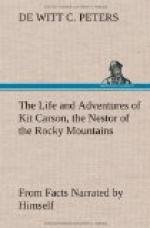[Footnote 12: Corral, a barnyard.]
This tribe of Indians, the Blackfeet, whose meddlesome dispositions have so frequently brought them in contact with Kit Carson in such and dissimilar affairs, occupy the country on the Yellow Stone River and about the head waters of the Missouri. There are other tribes in close proximity, the most important of which is the tribe called the Crows. When Kit Carson first entered upon his wild career the Blackfeet Indians numbered nearly thirty thousand souls. They were greatly reduced in numbers within the next six or seven years, between 1832 and 1839. In the last-named year, in consequence of the ravages of the small pox, heretofore alluded to and which prevailed the year previous, they had lost at least fifty per cent. The Indian computations of 1850, according to Brownell, give their numbers at only about thirteen thousand. They are one of the finest races of the American Aborigines. Powerful in frame and development; well trained in horsemanship, although in this they are surpassed by the Camanches; capable of great endurance; and, usually well fitted as to arms, dress, horse trappings, et caetera, they generally prove knotty customers as enemies. We ought not to pass by this notice of the Blackfeet Indians without calling the attention of the inquisitive reader to a remarkable proof which is afforded by the whole intercourse of these western trappers with the Blackfeet Indians, as thus detailed by Kit Carson, of an assertion hazarded some years ago by Charles De Wolf Brownell, in his admirable work upon the Indian races of North and South America. On pages 465-6, Mr. Brownell comes to the defence of the Crow tribe of Indians, which, up to that time, had been characterized as a “lawless, thieving horde of savages.” “But,” says Mr. Brownell, “those best acquainted with their character and disposition, speak of them as honest and trustworthy.” The adventures of Kit Carson among both the Crow and the Blackfeet Indians, we think, demonstrate pretty conclusively which of these contiguous tribes are the horse stealers. The Crows, it will be remembered, are more particularly




